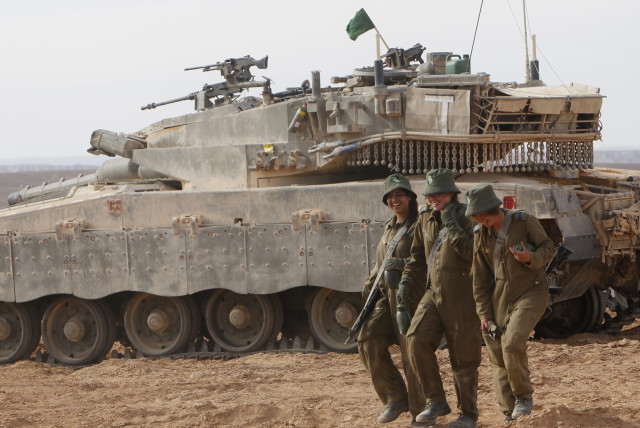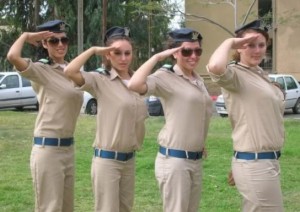
Ever since the first day of the current Israeli-Palestinian war on 7 October 2023, Israel’s media have been bristling with stories about heroic Israeli (not Palestinian, needless to say) women. How they received their mobilization orders just as men did. How they took their leave of home and hearth (including, in some cases, their children) just as men did. How they donned uniform, took up their weapons, and went out to fight just as men did. How some of them were killed just as men were. Here I want to say, loud and clear: almost all of it is nonsense. Nonsense in tomato juice, as we Israelis like to say. Nonsense of the kind that, in the long run, will do the IDF incalculable harm.
First, the nonsense. As of the time I am writing this at the end of November 2023, Israel’s mobilized armed forces number about 550,000 uniformed personnel, up from 180,000 in “ordinary” times. Of the latter figure between 25 and 30 percent are women. How many women have been called up and are currently on active service the IDF does not say. However, its official casualty list (in Hebrew) is available here. It shows that, as of 21 November, 392 IDF soldiers had lost their lives. Of those 40, or one in eight, were female.
At first sight one in eight does not appear totally unreasonable, given that most of the troops on active service are reservists and that far fewer female reservists than male ones were called up. However, pay attention to the following. The male casualties on the list are distributed over a period of 35 days. Not so the female ones, all but one of whom lost their lives during the first day of the war. Poor girls; serving as outlooks, insufficiently trained in the use of the infantry weapons with which they had been issued, unsupported either on the ground or from the air, they were in no position either to escape or to fight off Hamas’ surprise attack. Expiring as Odysseus’ maids did (Odyssey XXII 468-73):
[Like birds], with nooses around their necks
that they might die most piteously.
And they writhed a little while with their feet
but not for long.
Shame on you, IDF, for allowing such things to happen. And shame on you, penis-envy driven feminist fiends, for misleading your credulous women followers and pushing them in that direction! The much lower number killed since then suggests that, whatever female soldiers may have been doing from 8 October on, they hardly took part in any serious fighting. Case closed.
Second, the long term harm. It is a truism, observable throughout history and in practically every human field, institution or organization, that wherever women make their entry men leave. So in the case of cashiers, so in that of pharmacists, and so in that of psychologists among many others. In part they do so by default: no two persons can occupy a chair designed for one. But there is more to it than that. To quote Frederick the Great, a commander who knew a thing or two about fighting spirit, the one thing that can make men march into the muzzles of the cannons trained at them is honor. Specifically, I add, male honor, the kind more or less reserved for men that makes them attractive for women. Conversely, for a man to do a woman’s work is not an honor. It is humiliation. Think of Heracles who, at one point in his career, was punished by being made to dress as a woman and acting as a handmaid to the mythical Queen Omphale. Omphale, incidentally, reads like the female form of “navel,” but I’ll let that pass.
A man who competes with (or fights against) a woman and loses, loses. A man who competes with (or fights against) a woman and wins also loses; killing a woman may be profitable, but it is rarely considered honorable. Finding themselves in a lose/lose situation, no wonder many men prefer to withdraw. Supposing only the process goes on long enough, the military will end up by being left with hardly any men worthy of the name at all.
Nor does this warning refer to the IDF alone.




